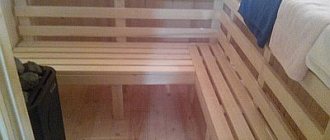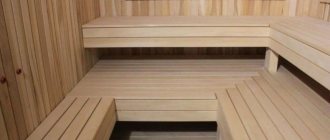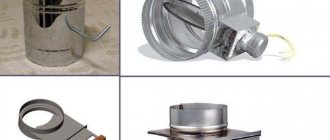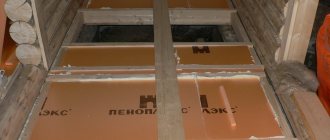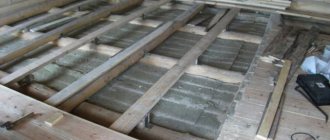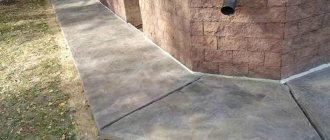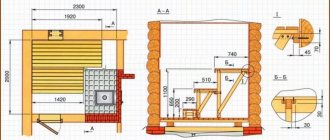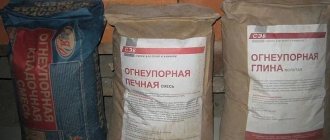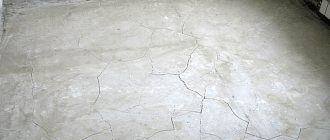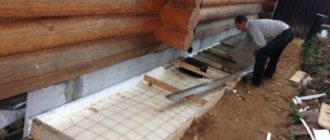Water suspended in the air and deposited on surfaces in the form of condensation is the main enemy of building structures. It slowly and steadily destroys all known types of materials, in the short term reduces strength properties and significantly reduces thermal insulation characteristics.
A vapor barrier protects the roofing pie from the negative effects of moisture. To arrange it in accordance with technological requirements, you should know why a vapor barrier is needed and how it is constructed.
Types and purpose of vapor barrier
The purpose of vapor barrier is hidden in the name - protecting structures from exposure to steam. In a gaseous state, water is always present both outside and inside the house. Everything is clear with the street - there the level of relative air humidity is most often higher than in the heated and residential part of the building (at sub-zero temperatures the situation changes). Indoor sources may be:
- any household appliances that operate on liquids at temperatures above the freezing threshold;
- plumbing equipment in the shower, bathroom, toilet room, kitchen;
- water evaporating during cooking and eating;
- plants and soil, especially after watering;
- surfaces that are subjected to wet cleaning or using liquid detergents;
- clothes and shoes, umbrellas and raincoats with capes after being outside;
- humans and domestic animals through the skin, breathing.
In order to reduce the level of humidity, ventilation is carried out through open doors and windows, and forced ventilation is arranged using equipment.
Traditional way to ventilate a house Source made-by.nl
However, this is not enough to ensure complete protection of certain structures from moisture. Some building materials without vapor barrier, due to their good breathability, cope with the effects of steam and dry out on their own without negative consequences. Others may lose useful properties (for example, mineral wool, when wet, begins to transmit heat up to 60% more). The risk of developing fungal and mold formations often increases, the wood begins to rot, a blue coating appears on it, and the metal rusts.
The installed vapor barrier layer prevents moisture from penetrating beyond the decorative finish, where the natural escape of vapor is difficult. Thus, the likelihood of condensation, dampness, and damage to the interior of structures is minimized. At the same time, we must not forget that almost any building material has a limited service life if installed correctly and shortened if technological requirements are violated. That is, the vapor barrier must be replaced periodically so that the barrier continues to perform its function at the proper level.
Possible consequences of improper insulation protection Source eco-kotly.ru
What is the difference from waterproofing
Often, ordinary people and novice craftsmen confuse the functional significance of vapor barrier materials with a water barrier. The second type of protection serves as an obstacle to water in any state of aggregation and does not have breathability. Technically, the waterproofing material is installed on the street side or on a rough base under floor finishing in rooms with high humidity levels. Some types of waterproofing are capable of retaining liquid in both directions, while others allow vapor to pass through. Many vapor barrier fabrics allow moisture to escape to one side.
Types of protection
One of the most well-known vapor barrier options is glassine. This is multi-layer paper that is impregnated with bitumen solution. In addition to flammability and fragility, there is such a significant disadvantage as low tensile and tensile strength. To replace this option, technologists have developed polymer fabrics that are free from the listed disadvantages. Based on their composition, only two groups of materials for vapor barriers can be distinguished: polyethylene and polypropylene.
Polyethylene
The budget type of vapor barrier copes with its task perfectly.
Technical polyethylene Source polibex.hu
See also: Catalog of companies that specialize in finishing materials and related work
However, it has one significant drawback - low tensile strength. If there is a damaged area, then the probability of a complete rupture of the canvas in an unpredictable direction can reach 100%. On trading platforms this group of materials is presented in various designs:
- smooth – analogue of technical film;
- perforated - there are many micro-holes along the entire surface through which moisture is removed (an additional condition for use is a ventilation gap along the canvas);
- reinforced - a reinforced version with polypropylene fabric or mesh, characterized by increased tensile and tear strength (often considered as a windproof fabric).
Film with reinforcing mesh Source molotok1.ru
A separate subtype of polyethylene film for vapor barrier is foil fabric. Its purpose is to protect the interior of the structure from moisture and reflect thermal energy into the room. The material is used in the construction of baths, saunas, swimming pools, wooden walls and ceilings. It is worth noting that on brick walls the effectiveness of such protection is the opposite. The film can withstand loads up to +120 degrees Celsius without releasing harmful substances into the air, maintaining its shape and quality.
Foil vapor barrier film is also manufactured in several modifications:
- with craft paper – low strength is observed, but the advantage is low cost;
- polymer-based - the increased price tag is justified by good strength properties;
- with thin-layer aluminum foil - stands out for maximum reflective efficiency, but is easily damaged;
- powder coated - the practicality of vapor barrier depends on the thickness of the aluminum coating.
Multilayer fabric with aluminum foil Source prom.st
Polyethylene materials can be monolithic or multilayer, usually with reinforcement. Here, the outer coating can be anti-condensation (it consists of viscose and cellulose fibers in layers). It is capable of repeatedly holding, storing and releasing condensed steam back for some time without letting it pass inside the protected insulation or structure. Single-layer vapor barrier, despite its low strength, often falls under regulatory recommendations. Also, film with a thickness of 200 microns is actively used in the construction of frame houses using Finnish technology.
Polyethylene samples are classified according to the working side. Symmetrical with respect to the thermal insulation, it can be laid on any surface. Asymmetrical, which includes foil and antioxidant sheets, it is important to install correctly so that the opposite effect is not created.
Where to buy vapor barrier materials
We provide a wide range of modern, high-quality vapor barrier materials for various purposes, which allows us to optimally solve any problem. You can see the cost of materials in our Price List. Since the company is a dealer of several manufacturers at once, there is always a wide range of materials from different brands in stock. To make an informed choice, it is necessary to take into account the density of the material and the cost per kilogram (it is the best price per kilogram in combination with high density that allows you to buy material with an optimal price-quality ratio).
The use of vapor barrier films will not only help protect housing from dampness and cold, create a cozy and comfortable atmosphere in the house, but will also guarantee to extend the life of all structures and help significantly save on major repairs.
Still have questions? Contact us by phone: +7 (495) 744-13-08
Video description
This video demonstrates the principle of operation of vapor barrier films and tested samples from different brands:
Installation features
The vapor barrier is laid under tension without sagging on the inside of the room, close to the insulation; on the outside, a ventilation gap must be installed. The canvas is fastened to the sheathing using a stapler (construction staples), self-tapping screws or nails in combination with wooden slats, with special tape or with an adhesive compound that is applied at the factory. The edges are overlapped to a width of 100-150 mm.
Fixing the fabric with an overlap using factory markers Source ecoteploiso.ru
Junctions with adjacent structures and seams between canvases must be sealed with specialized glue or tape. A small gap is left between the protection and further finishing.
Why do you need to protect walls from steam?
Operating principle of vapor barrier.
This type of protection is necessary for walls that are located in a fairly warm and at the same time damp room. This state of affairs is typical, for example, for a bathhouse or heated basements. In such rooms, warm air with small drops of water is formed, which, of course, needs to go somewhere.
This phenomenon, in fact, is called steam. Naturally, the steam no longer has any outlet other than the walls and ceiling. Due to the fact that steam formation is a process that occurs on an ongoing basis, it can cause significant damage to the structure. It is the vapor barrier that is designed to protect walls from the harmful effects of negative factors, and therefore prevent dampness and rotting of the walls.
Separately, it must be said that not only the walls of the bathhouse and basement need vapor barrier. Also, protection against steam should be organized in buildings that have insulation on the outside with low diffusion resistance or walls made of a material with a homogeneous base.
Let us highlight the point that a vapor barrier that is ideal for all types of structures has not yet been invented. Which type of steam protection should be given preference must be determined based on the design of the walls.
Briefly about the main thing
The vapor barrier film is designed to form a monolithic barrier that will prevent the passage of vapors into the protected insulation or structure.
The main materials for the production of canvases are polyethylene (budget options) or polypropylene.
Materials are distinguished according to various criteria: the number and purpose of layers, functions performed, degree of solidity and smoothness.
Laying of the canvases is carried out on the sheathing, maintaining a ventilation gap to remove moisture.
The solidity of the heat-protective layer is ensured by overlapping the edges by 100-15 mm and sealing all junctions and seams.
Ratings 0
Polyethylene
Traditionally available material with a thickness of only 1 mm. It should be fastened with concentration and care to prevent excessive tension, which could damage the film due to temperature changes.
There are several types of film protection:
- Perforated with small vapor-permeable holes;
- Non-perforated.
In the absence of perforation, along with steam, the flow of air is also limited, which affects the acceptable microclimate in the room. Polyethylene is practically not used at present, as there are more modern materials.
Popular manufacturers
There are many companies that specialize in the production of one or another type of vapor barrier material (universal, non-flammable, etc.), but the following manufacturers are among the best:
- "Izospan" (Russian, "Yutavek" (company from the Czech Republic - Juta);
- TechnoNIKOL (Russian manufacturer);
- Tyvek (American company DuPont);
- "Nanoizol" (Russian (company from Russia);
- "Izolon" (Ukrainian (Danish (Russian (Russian manufacturer);
- Klober (Germany);
- Fakro (Poland);
- Delta (German company Dorken).
Membrane films
The base of the vapor barrier membrane is polypropylene, with fiberglass mesh. The rough surface of the film creates a barrier that does not allow moisture to pass into both the wall and the insulation.
Due to the fact that the membrane is multi-layered, it stops not only the permeability of moisture, but also allows a small amount of air to pass inside.
Advantages:
- Can be used for wooden and frame houses;
- No need to create an air gap;
- Easy installation;
- Strength;
- Resistance to an increase in the number of mold microorganisms on the surface of the walls;
- Resistance to putrefactive processes;
- The material is harmless to humans;
- Extended service life - the film retains the original properties declared by the manufacturers for 50 years;
- Large temperature coverage during operation (from -60 to +80 °C);
- The presence of types of membranes reinforced with a layer of foil, which will reflect the heat coming from the house.
